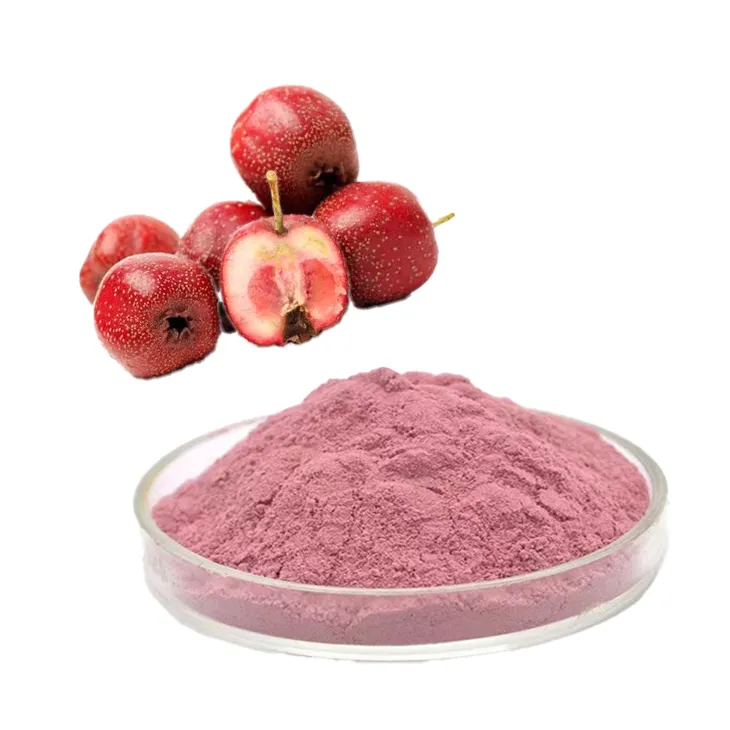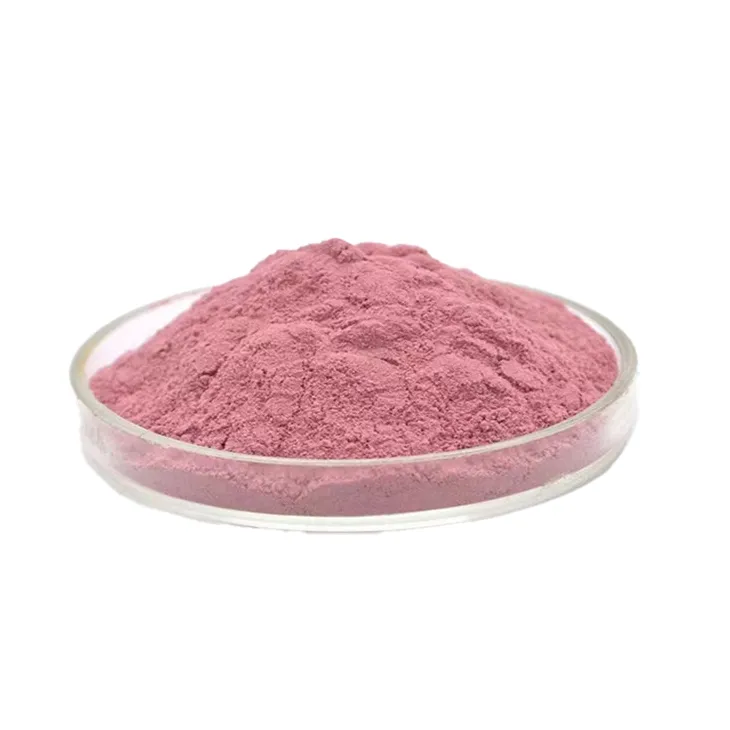- 0086-571-85302990
- sales@greenskybio.com
Hawthorn powder extraction technology and production process.
2024-11-26

1. Introduction
Hawthorn, a well - known fruit, is rich in various nutrients such as vitamins, flavonoids, and organic acids. These nutrients endow hawthorn with many health - promoting functions, such as promoting digestion, reducing blood lipid levels, and protecting the heart. With the increasing demand for natural health products, the extraction of Hawthorn powder has attracted more and more attention. High - quality Hawthorn powder can be widely used in the fields of food, medicine, and health products.

2. Hawthorn powder Extraction Technology
2.1 Solvent Extraction
Solvent extraction is a common method for extracting active ingredients from hawthorn. The principle is that the active ingredients in hawthorn are soluble in certain solvents. Different solvents can be selected according to the target components to be extracted.
- For example, if we want to extract flavonoids, ethanol is often a suitable solvent. Ethanol has a good solubility for flavonoids, and at the same time, it is relatively safe and easy to obtain. The extraction process usually involves soaking hawthorn powder or pieces in an ethanol solution at a certain concentration and temperature for a certain period of time. Then, through filtration and concentration, the flavonoid - rich extract can be obtained.
- When extracting organic acids in hawthorn, water can also be used as a solvent. Hawthorn contains a certain amount of organic acids such as citric acid and malic acid. By soaking hawthorn in water at an appropriate temperature, the organic acids can be dissolved in water. Subsequently, through processes such as filtration and evaporation, the organic acid - rich product can be obtained.
However, solvent extraction also has some disadvantages. For example, the solvent residue may be a problem. If the solvent is not completely removed during the subsequent processing, it may affect the quality and safety of the final hawthorn powder product. Therefore, strict control of the solvent removal process is required.
2.2 Mechanical Extraction
Mechanical extraction mainly refers to methods such as pressing. This method is mainly used to extract juice from hawthorn. Hawthorn fruits are first washed and crushed, and then pressed to obtain hawthorn juice.
- The advantage of mechanical extraction is that it is a relatively natural method without the use of chemical solvents, so there is no problem of solvent residue. The obtained hawthorn juice contains a large amount of water - soluble nutrients, such as some vitamins and sugars.
- However, the disadvantage is that this method can only extract water - soluble components, and some lipophilic active ingredients may be left in the pomace. In addition, the extraction rate may be relatively low compared with solvent extraction methods for some components.

3. Production Process of Hawthorn Powder
3.1 Pretreatment of Raw Materials
The pretreatment of hawthorn raw materials is an important step in the production of hawthorn powder.
- First, the selection of hawthorn is crucial. High - quality hawthorn should be selected, which is fresh, without obvious diseases and insect pests. The size and maturity of hawthorn also affect the quality of the final product. Generally, fully mature hawthorn is preferred.
- Then, the selected hawthorn needs to be washed thoroughly. This is to remove dirt, pesticides, and other impurities on the surface of hawthorn. After washing, the hawthorn can be drained.
- Next, depending on the extraction method, the hawthorn may need to be further processed. For example, if mechanical extraction is used, the hawthorn may need to be crushed into an appropriate particle size to facilitate the pressing process. If solvent extraction is used, the hawthorn can be cut into small pieces or ground into powder according to the specific requirements.
3.2 Extraction
As mentioned above, the extraction can be carried out by solvent extraction or mechanical extraction methods.
- If solvent extraction is used, after the pretreatment of hawthorn, it is put into the selected solvent according to a certain ratio. For example, if ethanol extraction is carried out, the hawthorn pieces are soaked in an ethanol solution with a certain concentration (such as 50% - 70% ethanol). The soaking time is usually several hours to tens of hours, depending on factors such as the type of target component and the temperature. During this process, it is necessary to ensure proper agitation to promote the dissolution of active ingredients.
- If mechanical extraction is used, the crushed hawthorn is put into the press. The pressure applied should be appropriate to ensure the maximum extraction of juice while avoiding excessive crushing of pomace. The extraction efficiency can be improved by repeating the pressing process several times.
3.3 Purification
After the extraction process, purification is often required to remove impurities and obtain a purer product.
- In solvent extraction, the obtained extract contains not only the target active ingredients but also some impurities such as proteins, polysaccharides, and pigments. Filtration is a common purification method. By using filters with different pore sizes, large - molecular - weight impurities can be removed. For example, a filter with a pore size of 0.45 μm can remove most of the protein and polysaccharide impurities. In addition, chromatography methods can also be used for further purification. For example, column chromatography can be used to separate flavonoids from other impurities according to their different adsorption and elution characteristics.
- In mechanical extraction, the obtained hawthorn juice also needs purification. Centrifugation is often used to remove suspended solids in the juice. By centrifuging at a certain speed (such as 3000 - 5000 r/min), the solid impurities can be separated from the juice. Then, filtration can be carried out again to further remove small - particle impurities.
3.4 Drying
The drying process is the final step in the production of hawthorn powder, which is crucial for obtaining a dry and stable product.
- There are several drying methods available. One common method is spray drying. In spray drying, the purified Hawthorn Extract or juice is sprayed into a hot air chamber. The hot air rapidly evaporates the water in the liquid, and the solid particles are formed and collected. Spray drying has the advantages of high drying speed, good powder quality, and can maintain the activity of active ingredients to a certain extent.
- Another method is freeze - drying. Freeze - drying is carried out at a low temperature and low pressure. First, the Hawthorn Extract or juice is frozen, and then the ice is directly sublimated into water vapor under low - pressure conditions. Freeze - drying can better preserve the structure and activity of active ingredients, but the cost is relatively high.
- Vacuum drying is also an option. In vacuum drying, the hawthorn product is placed in a vacuum environment, and the water is removed by heating at a lower temperature. This method can reduce the oxidation of active ingredients due to the absence of oxygen in the vacuum environment.

4. Conclusion
The extraction technology and production process of hawthorn powder play a crucial role in obtaining high - quality hawthorn powder products. Solvent extraction and mechanical extraction each have their own advantages and disadvantages, and the appropriate extraction method should be selected according to the target components and product requirements. In the production process, from raw material pretreatment to extraction, purification, and drying, each step needs to be carefully controlled to ensure the quality and safety of the final hawthorn powder product. With the continuous development of technology, it is expected that more advanced and efficient extraction and production technologies will be applied to the production of hawthorn powder in the future, so as to better meet the market demand for natural health products.

FAQ:
Q1: What are the common solvents used in solvent extraction for hawthorn powder?
Common solvents include water, ethanol, or a combination of both. Water is often a preferred solvent as it is safe and can extract many water - soluble nutrients from hawthorn. Ethanol can be used, especially when targeting certain organic compounds. The choice of solvent depends on the specific components one wishes to extract from the hawthorn.
Q2: What is the purpose of the pretreatment step in the production process of hawthorn powder?
The pretreatment step serves multiple purposes. Firstly, it helps to clean the hawthorn fruits, removing dirt, debris, and any damaged parts. Secondly, it may involve processes like washing and sorting, which ensure the quality of the raw material. Pretreatment also might include steps such as cutting or grinding the hawthorn to an appropriate size, which can increase the surface area and thus enhance the efficiency of the subsequent extraction process.
Q3: How does mechanical extraction work in the context of hawthorn powder extraction?
Mechanical extraction typically involves using physical force to obtain substances from hawthorn. For example, pressing the hawthorn fruits can squeeze out the juice, which contains many of the nutrients. Another method could be grinding the hawthorn into a paste and then using centrifugal force to separate different components. Mechanical extraction is often more environmentally friendly compared to some solvent - based methods as it does not involve the use of chemicals.
Q4: What are the key factors to consider in the drying step of hawthorn powder production?
The key factors include temperature, drying time, and the method of drying. The temperature should be carefully controlled to avoid over - drying or damaging the nutrients in the hawthorn powder. Too high a temperature can cause degradation of heat - sensitive components. Drying time should be sufficient to remove moisture but not so long that it affects the quality. Different drying methods such as air - drying, freeze - drying, or oven - drying can be used, and the choice depends on factors like cost, scale of production, and the desired quality of the final product.
Q5: Why is purification necessary in the production of hawthorn powder?
Purification is necessary to remove impurities that may be present after extraction. These impurities can include unwanted plant materials, residual solvents, or other substances that may affect the taste, quality, or safety of the hawthorn powder. Purification steps can ensure that the final product is of high quality, pure, and suitable for various applications such as in the food or pharmaceutical industries.
Related literature
- Advances in Hawthorn (Crataegus spp.) Research: Phytochemistry, Pharmacology, and Clinical Applications"
- "Hawthorn Extract: Production, Characterization and Potential Health Benefits"
- "The Technological Aspects of Fruit Powder Production: A Case Study of Hawthorn (Crataegus spp.)"
- ▶ Hesperidin
- ▶ citrus bioflavonoids
- ▶ plant extract
- ▶ lycopene
- ▶ Diosmin
- ▶ Grape seed extract
- ▶ Sea buckthorn Juice Powder
- ▶ Beetroot powder
- ▶ Hops Extract
- ▶ Artichoke Extract
- ▶ Reishi mushroom extract
- ▶ Astaxanthin
- ▶ Green Tea Extract
- ▶ Curcumin Extract
- ▶ Horse Chestnut Extract
- ▶ Other Problems
- ▶ Boswellia Serrata Extract
- ▶ Resveratrol Extract
- ▶ Marigold Extract
- ▶ Grape Leaf Extract
- ▶ blog3
- ▶ blog4
-
Chinese Withania somnifera Extract Factory.
2024-11-26
-
中国松树皮提取物粉粉末供应商
2024-11-26
-
High - quality Marigold Extract Products.
2024-11-26
-
100% Pure Natural Mango - Flavored Powder.
2024-11-26
-
Mangosteen extract powder
2024-11-26
-
Ivy Extract
2024-11-26
-
Rose Hip Extract
2024-11-26
-
Maca Extract
2024-11-26
-
Acai Berry Extract
2024-11-26
-
Andrographis Paniculata Extract Powder
2024-11-26
-
Agaricus Blazei Extract
2024-11-26
-
Cactus Extract
2024-11-26
-
Dandelion Leaf Extract
2024-11-26
-
Lotus leaf extract
2024-11-26





















